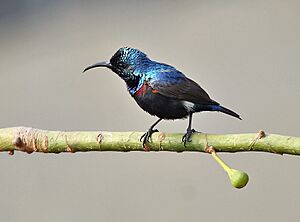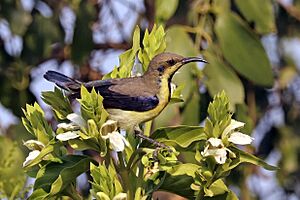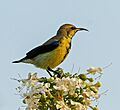Purple sunbird facts for kids
Quick facts for kids Purple sunbird |
|
|---|---|
 |
|
| Male C. a. intermedius in breeding plumage | |
 |
|
| Male C. a. asiaticus non-breeding plumage
|
|
| Conservation status | |
| Scientific classification | |
| Genus: |
Cinnyris
|
| Species: |
asiaticus
|
| Synonyms | |
|
Arachnechthra intermedia |
|
The purple sunbird (Cinnyris asiaticus) is a small, colorful bird. It belongs to the sunbird family. You can find these birds mainly in South and Southeast Asia. They also live in parts of the Arabian Peninsula.
Like other sunbirds, they mostly eat nectar from flowers. But they also catch insects, especially when they are feeding their young. Purple sunbirds fly very fast and straight. They can hover like a hummingbird to drink nectar. Often, though, they just perch on a flower.
Male purple sunbirds can look all black in bright sunlight. But if you look closely, or in good light, you will see their beautiful purple shine. Female sunbirds are olive-brown on top and yellowish underneath.
Contents
About the Purple Sunbird
This small sunbird has a short beak and a dark, square-shaped tail. Males and females look quite different. They are less than 10 centimeters long. Their beaks curve downwards. They have special brush-tipped tongues. These help them drink nectar from flowers.
Male Purple Sunbirds
Male sunbirds are shiny metallic blue or purplish-black on their upper bodies. Their wings look dark brown. When they are ready to breed, their undersides are also purplish-black. At other times, non-breeding males might have a black stripe on a yellow belly.
Breeding males sometimes show off bright yellow feathers. These are called pectoral tufts. They are found near their "armpits." There is also a bright blue patch on their shoulders. A maroon (reddish-brown) shine around their neck is most visible during breeding season.
Female Purple Sunbirds
Female purple sunbirds are olive-brown on their backs. Their undersides are yellowish. They have a pale stripe above their eye. There is also a darker stripe through their eye. Their throat and chest are yellow. This color fades to pale near their tail. The outer tail feathers have white tips on both males and females.
Young sunbirds look like the females. But young males will grow black feathers as they get older.
Where Purple Sunbirds Live
Purple sunbirds live in many places. They are found from West Asia, across the Indian subcontinent, and into Southeast Asia. These birds usually stay in the same area all year. They do not travel long distances.
You can find them in light forests and gardens. They even live in busy cities. Sometimes, they move locally, especially in dry areas. For example, in parts of northwestern India and Pakistan, many arrive before summer.
Purple Sunbird Behavior and Life Cycle
These birds are very noisy. They call loudly and will gather to chase away predators like owls. Their song is a fast rattling sound. It ends with ringing, metallic notes. They also make "chwit" or "chwing!" sounds.
Breeding and Nests
The main time for breeding is before the Monsoons. This is from April to June in northern India. In Sri Lanka, it's from January to June. When they are feeding, they often flick their wings. They usually perch on flowers to find nectar. They rarely hover.
Purple sunbirds help pollinate many plants. These include Butea monosperma and Acacia. But sometimes, they "steal" nectar. They do this by cutting a hole in the base of flowers like Hamelia patens. They also eat small berries and even cultivated grapes. Sometimes, they catch insects while flying.
During courtship, the male tries to impress the female. He raises his head and spreads his tail. He flutters his wings partly open. This shows off his yellow pectoral tufts. He also sings to the female.
The nest is shaped like a pouch. It is made from spiderwebs, thin plant pieces, and bark. The entrance hole is on the side. It often has a little roof over it. The female builds almost the entire nest. The materials are not woven. Instead, spiderwebs hold most of it together. Building the nest can take five to ten days. The bird expands the inside by opening its wings and turning around.
In Sri Lanka and southern India, they sometimes use spiderwebs from social spiders. They line these webs to make their nests. Usually, two eggs are laid. The nest often hangs from a low branch. Thorny plants are a common choice. But nests can also be near people's homes. They might be attached to wires or other man-made things. Sometimes, they even build nests inside unused rooms!
Only the female bird sits on the eggs. They hatch after 15 to 17 days. Male birds help feed the chicks. But females do most of the work. They make more trips to feed the chicks as they grow older.
Sunbirds have been known to live for almost 22 years in zoos.
Gallery





